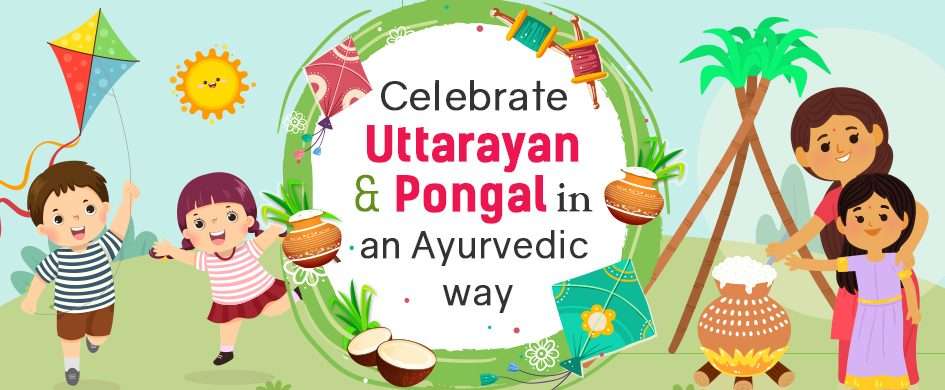
How to Celebrate Uttarayan & Pongal in an Ayurvedic way
- by Baby Organo
- 2 min 14 sec
Table of Contents
Are you longing for a bright sunny day after a long cold winter? Perhaps, after such a long period of cold the most pleasant change of all is when the signs of Spring begin to appear. That’s the kind of renewal that Makar Sankranti or Pongal brings forth, after months of cold weather!
Wondering what is the significance of Pongal and what has it got to do with Ayurveda? It all lies in the timing, the customs and the traditions of the festival.
Pongal marks the Uttarayana
The day of Pongal falls on 14th of January every year and marks the transition of the Sun into the zodiac sign of Makara rashi (Capricorn) on its celestial path. This movement is called Uttarayana in Vedic literature. It also marks the end of longer cold nights and start of warmer and longer days. So, Pongal is the first day of the new year to enjoy the warmth of the sun outside and to celebrate the advent of Spring with your little ones!
It is a festival that is celebrated all over India with kite flying, wishing each other with specially made til and jaggery sweets and many other rituals. According to Ayurveda many of these Pongal food and traditions have significant effect on our health.
The tradition of kite flying
On the day of Pongal the sun starts moving northwards i.e. Uttarayana. According to Ayurveda, when the sun moves in the northern hemisphere, its rays have a medicinal effect on the body.
During the winter season cold induced seasonal disorders like flu, cold and various respiratory issues are rampant especially among children. This happens because of absence of sunlight and warmth. And Ayurveda says regular basking in the sun helps in eliminating the excess doshas (toxins causing disease) from the body.
So when the children come out in the sun to fly kites their body gets exposed to the sunrays and absorbs the very important Vitamin D required for their bones and skin. Thus their body gets cleansed of all the infections, cold, cough and dry skin that had affected them in the winter season.
But as parents to little kids you need to be extra careful while allowing your kids to fly kites in the sun. Take the following precautions to keep them safe:-
- do not allow your kids to run after kites
- do not allow your kids to fly kites on open terrace without surrounding walls
- fly in a safe open place and away from trees or power lines
- never leave kids to fly kites unassisted
Unique food having medicinal values
Like the other Indian festivals Pongal is also associated with unique food preparation that have medicinal and nutritional values, based on the timing of the festival and the ingredients used in them.
Unique food having medicinal values
During the Pongal rituals we make an offering of sweets made with sesame seeds, jaggery, nuts, etc. to the deities and distribute amongst each other too. Til and gur are prized in Ayurvedic diet as two of the most winter-perfect foods. Do you know why this practice has been going on since ages? It is because these ingredients have immense beneficial properties.
Nutritional values of Sesame (til - Sesamum Indicum) seeds
According to Ayurveda, illness arises when the three Doshas (Vata, Pitta & Kapha) of our body are out of balance. An Ayurvedic diet suggests regular intake of sesame can alleviate Vata and normalises Pitta and Kapha in our body.
Sesame seeds are oily and hot in nature. Giving your children food prepared with sesame provides the much needed heat to keep their body warm and protected from cold.
Children with low digestive power are suggested to have sesame ladoos every day to improve it. Sesame strengthens your child's immunity power, intelligence and also good for their teeth and hair growth. As it is rich in Vitamin E, it improves quality of skin by moisturising the dry skin and strengthening the bones, muscles and joints. Thus sesame oil massage for babies and kids is also recommended in winter season in Ayurvedic treatments.
Nutritional values of Jaggery
Jaggery is a good substitute for sugar and is used in many Ayurvedic medicines. Being loaded with essential minerals like iron, zinc and selenium, jaggery can clean and detoxify the blood, increase the volume of urine and faeces, boost immunity, promote digestion strength, prevent free-radical damage and also protect your child against infections.
Nutritional values of Ghee and Nuts
Needless to say that, high in minerals and essential fatty acids, nuts help ward off cold and common flus along with ghee, a perfect warming food during the winter season. The vital fatty acids present in these two ingredients of Ayurvedic diet help nourish and hydrate the dull and dry skin.
So let your kids enjoy the delicious snacks of tilkut, til patti, til poli, til laddoos , gajak, chikkis and various other delectables made with sesame seeds, peanuts, ghee and jaggery during Uttarayana and Pongal and reap the benefits of their nutritional values.
With so many mouth-watering delicacies available during the festival of Pongal make sure your child does not intake excess of them as this might cause discomfort to them.
So, enjoy the festival with your little ones and follow these Ayurvedic tips to keep them healthy and active. Let the auspicious festival of Pongal brings happiness, joy and prosperity to everyone.
- Tags:
- Parenting tips

